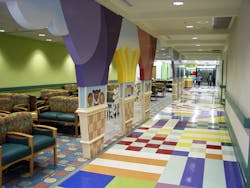How does a pediatric health system engage families more fully and improve service and loyalty? The leaders at the Wilmington, Delaware-based Nemours Children’s Health System have been on a multi-year journey around those goals, Gina Altieri told her audience gathered at the Grand Hyatt Hotel in downtown Denver, during the Health IT Summit in Denver, sponsored by Healthcare Informatics.
On Friday, July 13, Altieri, the senior vice president, corporate services, at Nemours, spoke on the topic “Developing a Technology Strategy to Increase Patient Engagement, Improve Satisfaction, and Deliver Better Care,” tracing her organization’s journey forward in working to enhance consumer loyalty through technology-facilitated improvement of care delivery and service quality.
Nemours Children’s Health System, which is anchored by the Nemours/Alfred I. duPont Hospital for Children in Wilmington, and by the Nemours Children’s Hospital in Orlando, treats 410,000 children every year, for a total of 1.7 million annual encounters, across 90 pediatric care locations in five states. All of its physicians are employed. And the health system sponsors more than 300 active research projects and clinical trials within its Nemours Research Centers for Excellence division. Furthermore, Nemours achieved Stage 7 status on both its inpatient and outpatient sides, in 2017, recognizing its high level of electronic health record (EHR) development, by the Chicago-based Health Information & Management Systems Society (HIMSS), and in February 2011, received the HIMSS Davies Organizational Award of Excellence for 2010, for its effective use of health information technology to improve the safety and quality of patient care.
Foundations first
Recapping a history of “two decades of IT evolution,” Altieri noted that “We decided a long time ago to eliminate all the separate clinical and business systems we had. In 1999, we quickly installed Cerner for inpatient, and then started to install our outpatient EMR. Several years later, we decided to have the revenue cycle management and all business systems put on two high-end platforms, and then decided to have all our applications on one platform, and replaced Cerner with Epic. And then we decided to dabble in telehealth, and we were building our Nemours Children’s Hospital in Orlando. And that really was all of the technical infrastructure we needed, in order to do what we’re doing now, as well as to build the team we needed, to leverage all that technology.”
Further, Altieri recounted, “When I first started, we had paper charts, and a lot of equipment we didn’t realize, and no sense of organization. And you really cannot function like that it today’s world; it’s just too expensive and inefficient. And the information security aspects are pretty important right now; so we really did need to invest information security; the government’s demanding it, but so are consumers. The other thing we’re doing,” she said, “is that because we had these systems for 20 years—the lifetime of a child—we had a lot of very valuable data. So we had been using the data behind the scenes, and we’ve been providing it to the frontline in an easy self-service way, so that the physicians have access to the data, the executives do, so that more and more people actually understand what the data’s been telling them. That’s been effective.”
Innovation for a purpose
A lot of different technology-facilitated innovations are taking place right now at Nemours, Altieri reported. For one thing, the health system’s leaders decided to go ahead and post ratings for all physicians, including consumer comments, on the organization’s website. “That wasn’t an easy task, because we posted them all, good and bad,” and there was some physician alarm at the prospect. “But we’re helping them to know what’s happening in real time. So when they see a Press Ganey result, for example, they can understand what’s going on in the consumers’ minds. And it’s been very helpful.”
Meanwhile, she added, “At Nemours, we have one integrated radiology department, so all the radiologists read all the studies. In fact, we have a 13-minute turnaround for all the [digital images], which is pretty remarkable.”
Further, Nemours has been successful with a remote-monitoring system in which trained paramedics monitor patients in their patient rooms 24/7. Up to 400 patients are monitored continuously at any time, in both the Wilmington and Orlando facilities, from a single location at the Orlando hospital. Nemours was the first pediatric hospital system in the world to install such a system, and, Altieri noted, parents have been strongly in favor of the capability.
On the softer side, she mentioned, “We also bring Santa from the North Pole to patients in the child life area or to the bedside. The elves are actually executives from some of the vendor companies. And the North Pole is actually next door to my office. The children are enchanted by this.”
Then, speaking of the journey forward in “listening to the consumer,” Altieri framed the bigger picture around consumer engagement. “One misconception about companies like Amazon and Lyft,” she said, “is that it was the technology that changed everything” in terms of those companies’ abilities to disrupt their business sectors. “But it wasn’t the technology alone that was a disruptor. It was that they met the consumer where they were. And if we don’t provide the consumer with what they want, they’ll go elsewhere.” Historically, she noted, “We’ve been OK in healthcare with forcing patients to call during the hours of 9 to 5, to schedule appointments. But what we’ve learned is that most people are scheduling online in off hours. In primary care, that can work OK; but in specialty care, we do demand a lot of information prior to the visit,” and that can pose challenges in terms of the ability to gather all the relevant information online. “The concern among providers is continuity of care; but the concern of the consumer is that they want to be seen. So we’re working through that. We clearly need to engage the millennials,” she said, “and that means meeting where they are. They’re ready for telehealth; they’re willing to pay for convenience; they look to the research and what others are saying about providers, before they make a decision. So a social media presence is very important. So then we hone down to the Nemours parent, and find out what’s important to us. They value quality, respect, and environment of care over cost. And they will choose hospitals based on internet searches.”
As a result of the research that she and her colleagues conducted, Altieri reported that “We came up with Nemours Anytime, Anywhere. We want to be that trusted advisor” for consumer medical information. “Our aim is to expand a more accessible continuum of care within our communities to be a more proactive partner in guiding and empowering parents throughout their children’s development. We’re trying to tie everything together, so that their experience is a seamless one and they only have to go to one place, and we remove all the friction that exists today. So we created the Center for Health Delivery Innovation. We have editors, data scientists, developers, design thinking experts. We use agile methodologies to work with patients and families and providers every step of the way.”
In short, Altieri said, success in all these areas requires developing an entire “ecosystem” of technology infrastructure to support consumer engagement. She cited Nemours KidsHealth; Nemours Prevention & Population Health; the health system’s HIMSS Stage 7-level core IT infrastructure; and telehealth capabilities, as composing that constellation of supports. What’s more, she said, in all this, “You can’t just pull solutions off the shelf; you’ll no engagement with providers and patients/families.”
A consumer insights and digital strategy
“We also created a consumer insights and digital strategy, to analyze our consumers’ digital footprint and optimize leveraging of out digital assets,” Altieri continued. And in that regard, “We’ve been able to track what parents are doing when they go to our site, and we’re trying to direct them to schedule an appointment or have a video chat and get more connection to Nemours. And what’s the click-through rate? Why did they stop at a particular point in the process?”
A lot of learnings have been absorbed along the way, Altieri noted. “Originally,” she said, “the patient portal was a little clunky, people we’re really using it. But we’ve embedded our kids’ health content, our patient instructions, and have automated the onboarding of the patient portal to make it easier. Everything has to be made easier.”
Further, she said, “We’ve been doing telehealth for five years, We call it Nemours CareConnect. We have partner facilities. They want to retain patients. And we want to transfer only the really complex cases to our children’s hospitals. And we’ve turned it to direct-to-consumers. 24/7, a Nemours board-certified physician can provide telephonic care. In addition, 400 specialists have also been trained to do consults from the hospital. We’re also in schools. Right now, they’re in special-needs schools. But eventually, they’ll be in general mainstream schools. We’re also on cruise ships.”
Meanwhile, Altieri reported, “The Center for Health Delivery tied all these separate assets together,” and created an app for asthma management that “touches the entire continuum of care, and works not only for the provider, but also for the patient and family.” In developing the app, she said, “We asked the providers, what problem can we help you solve? And they were saying, most of the problems have to do with gaps—what’s happening in the home and other things that might be triggering this?” And she showed the audience a video involving actors that walked through what a mother and her daughter experienced as they were guided through telehealth and in-person encounters around the daughter’s asthma, with caring, empathetic interactions with physicians and other clinicians, and successful follow-up around questions and concerns. What the video depicted was a thorough and comprehensive approach to helping parents with children with chronic illnesses to have their children’s medical issues handled successfully, with caring and convenience. One particularly exciting element of the use of the consumer app as part of that continuum of care is that the parent can make notes on exercise, activities, symptoms, etc., that are relevant to their child’s condition, and those are then incorporated in the information that the clinicians caring for the child have at their disposal.
“We’ve launched that proof of concept, it’s on the app store. And we had our first telehealth visit through the app last week,” Altieri noted, after showing the video of that care delivery and management process. “Now, we’re working on an app for cardiac care, and then we’ll move on to add one for diabetes, and then for WellChild care, which will be the umbrella for all of this.”
In the end, she noted, it’s all about listening to consumers and finding out what they want and need, and figuring out how to deploy technologies that facilitate improved care delivery and management, and support consumer convenience and wants. Nemours leaders, she emphasized, will continue to listen and to act accordingly.



